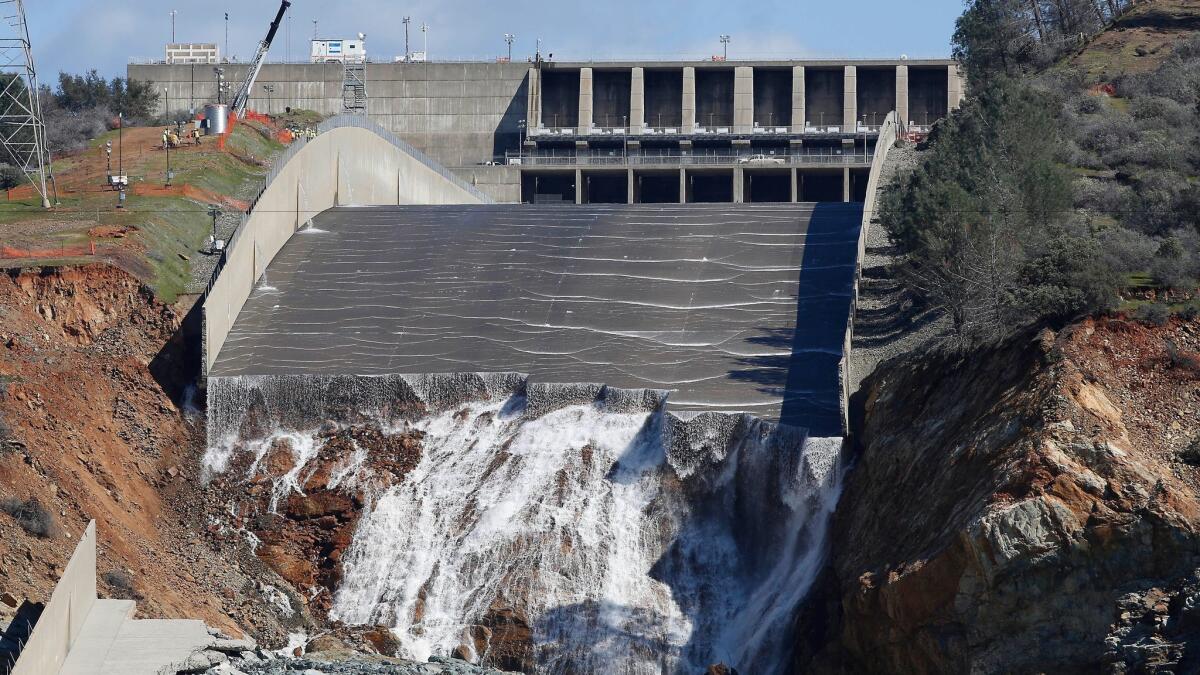Facing a tight deadline, state outlines initial repair plans for broken Oroville spillway

State officials said Thursday that they hope to sign a contract for reconstruction of the heavily damaged Lake Oroville spillway by April 17.
“We’re working very fast,” said Bill Croyle, acting director of the Department of Water Resources, which is under intense pressure to get the spillway in shape before the start of next winter’s rainy season.
Although Croyle said the department has to conduct in nine months design and construction work that would normally take several years to complete, he expressed confidence that it was possible.
“This is standard stuff that has been used very recently here in California,” Croyle said. “They can get this done.”
At a briefing in Oroville, department officials outlined preliminary design plans for rebuilding the upper part of the broken main spillway as well as measures for strengthening the eroded emergency spillway that came close to unleashing a disastrous torrent of water in February.
They can get this done.
— Bill Croyle, acting director of the state Department of Water Resources
The state does not yet know the cost of the repairs, which is likely to be higher than the $100-million to $200-million estimate officials made earlier this year.
The reconstruction plans, which must be approved by federal regulators, are evolving as crews take rock core samples from the spillway hillside. In some places, Croyle said, the samples have found several feet of concrete beneath the spillway, revealing “a more robust structure” than anticipated.
In February, a huge crater developed in the long concrete chute that serves as the reservoir’s main spillway, prompting dam managers to reduce releases. That caused lake levels to rise so high that water started to wash over the unpaved emergency spillway for the first time in Oroville’s history.
The next day, erosion beneath the lip of the emergency spillway threatened to eat a hole in the side of the overflowing reservoir, prompting the downstream evacuation of more than 100,000 people.
Repair plans call for contractors to replace portions of the upper, intact main gated spillway by Nov. 1. The new chute would be designed to handle flows of 270,000 cubic feet of water per second. That is somewhat less than the capacity of the damaged spillway but far more than historic spillway releases.
A type of concrete that is pressed into place with heavy rollers would be used to fill areas of eroded rock near the lower chute, which would be partially rebuilt this year to accommodate releases of 100,000 cfs. Any flows above that threshold next winter would tumble down the eroded channel next to the chute. Work would be finished in 2018.
Repair options for the emergency spillway include buttressing the cement weir at its head with roller-compacted concrete and laying an apron of the same material that would extend partway down the hillside. To prevent erosion of the head, a concrete wall would be poured underground and anchored into bedrock.
The wall, considered the most critical part of the emergency spillway repair, would be constructed this year, and the other parts could be finished in 2018.
Twitter: @boxall
More to Read
Start your day right
Sign up for Essential California for news, features and recommendations from the L.A. Times and beyond in your inbox six days a week.
You may occasionally receive promotional content from the Los Angeles Times.







